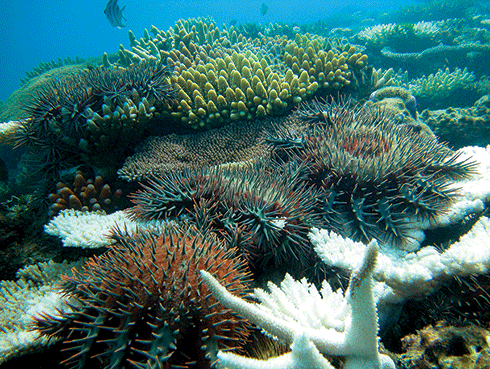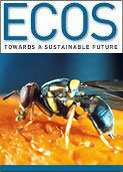
|
Published: 18 November 2013
Pheromones to protect GBR from crown-of-thorns?
The Australian Government Reef Rescue program recently provided funding to the Australian Institute of Marine Science (AIMS) to investigate the potential for a novel pest control technology targeted at the biggest biological threat to the Great Barrier Reef, the crown-of-thorns starfish.

|
|
One single crown-of-thorns adult can consume from 6 to 10 square metres of live coral per year; feeding aggregations can do untold damage. Credit: AIMS
|
The funding has led to a research consortium being established between the Australian Institute of Marine Science (AIMS), the University of the Sunshine Coast (USC) and the Marine Genomics laboratory at the University of Queensland to develop the new technology to manage the crown-of-thorns.
The USC researchers are Senior Lecturer Dr Scott Cummins, an Australian Research Council (ARC) Future Fellow in molecular and cellular biology, and USC Research Fellow Dr Tianfang Wang.
‘Population explosions of crown-of-thorns starfish are one of the major causes of coral demise,’ Dr Cummins said. ‘This is a native pest damaging a World Heritage asset, and requiring novel control measures.’
He said ‘feeding aggregations’ of crown-of-thorns starfish could cause significant loss of coral cover on infested reefs, with individual adults consuming from 6 to 10 square metres of live coral per year.
‘The oceans are a “smelly” world and odours in water can trigger critical behaviours,’ Dr Cummins said. ‘The ability to detect and respond to chemical signals is essential in all aspects of the lives of aquatic animals.’
He said pheromone communication in crown-of-thorns starfish could induce aggregations, allowing for specifically targeted control.
‘Pheromone-based technologies to manage pests are used worldwide for many species of insects. Our goal is to demonstrate that a similar approach may be used in the marine environment to enhance the effectiveness of current control methods.’
Dr Mike Hall of AIMS said a breakthrough in the manipulation of the animal’s behaviour could lead to a new generation of control technologies for the crown-of-thorns. AIMS is a world leader in the biology of crown-of-thorns starfish and its new SeaSim marine aquarium complex will be used by researchers to understand the starfish’s behaviour and identify its vulnerabilities.
Source: USC



